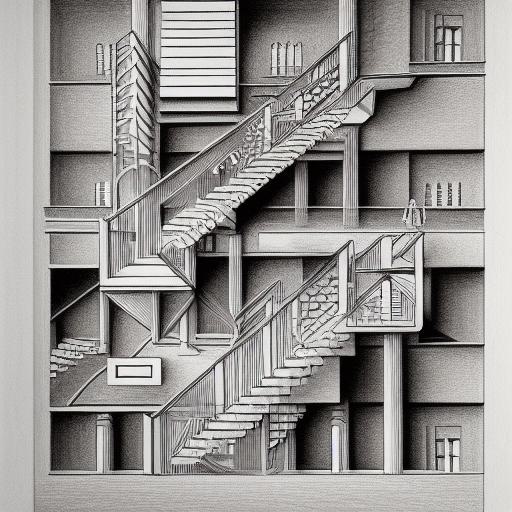What is Escher lithography?
Escher lithography is a type of printmaking that was popularized by the Dutch artist M.C. Escher in the mid-20th century. Lithography is a printing technique that involves creating an image on a flat stone or metal plate using a greasy substance. Then, the plate is dampened with water and rolled with ink, which only adheres to the greasy parts of the image. Finally, the inked plate is pressed onto paper, producing a printed image.
Characteristics of Escher’s lithographs
Escher’s lithographs are known for their intricate and mind-bending designs, often featuring impossible shapes and illusions. He would spend hours creating detailed sketches and studies before transferring the image to the lithography plate. The process of creating a lithograph could take months or even years, as Escher was known for his meticulous attention to detail.
Escher’s lithographs have become iconic, and his work continues to inspire artists and designers today.
What is AI-generated art?
AI-generated art is artwork created using artificial intelligence algorithms, enabling fast and efficient image production. This method has numerous advantages over traditional art-making techniques, including the ability to experiment with different styles and techniques, as well as the flexibility to create designs that meet specific requirements. Moreover, AI-generated art promotes diversity and inclusivity within the art industry by providing a platform for artists from various backgrounds to express their unique experiences and perspectives.
Visual Paradigm Online is an online tool that designers can use to easily integrate AI-generated art into their projects. Artists can also explore the virtually limitless creative possibilities offered by this technology by generating their own AI-generated art on websites like Stable Diffusion, Midjourney, or Dalle 2.
How to create this prompt?
When creating an AI image prompt like the one given, it is important to include specific details that will guide the algorithm in generating the desired image. The prompt includes several key elements such as a “drawing of a staircase like a maze in an architectural building” which provides a basic structure for the image. This prompts the algorithm to create a drawing of a staircase that resembles a maze and is situated within an architectural building.
Additionally, the prompt mentions “an engraving by MC Escher” which is a reference to the famous Dutch artist known for his intricate and impossible architectural designs. This reference to MC Escher’s work helps the algorithm understand the surrealistic and impossible nature of the prompt and incorporate those elements into the generated image.
Furthermore, the prompt includes references to “Tumblr,” “surrealism,” “inside MC Escher architecture,” “MC Escher illustration,” and “MC Escher art.” These references help the algorithm understand the specific aesthetic and artistic style that the prompt is meant to emulate. For instance, the reference to “surrealism” guides the algorithm to create an image that defies conventional expectations and may have dreamlike or hallucinatory qualities.
Overall, the key to writing an effective AI image prompt is to be specific and detailed in your description. Including specific references to artists, styles, and other visual elements can help guide the algorithm in creating an image that accurately reflects your intentions. The prompt should provide enough detail to give the algorithm a clear idea of what you want, but also leave room for creative interpretation and innovation.


